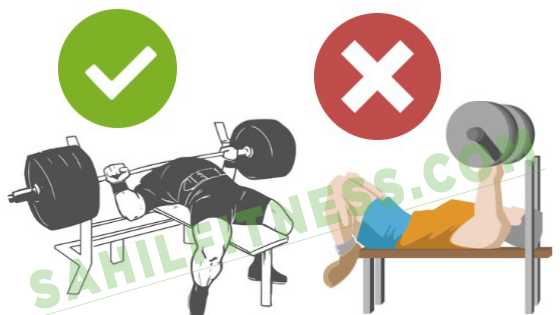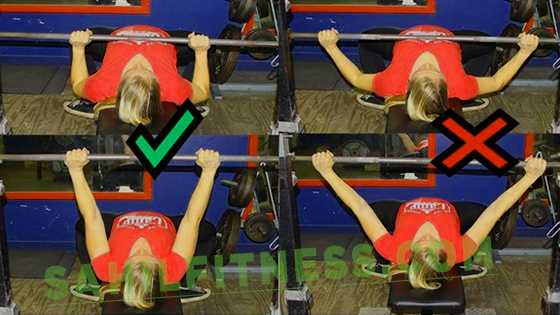How to Bench Press 5 Tips To Avoid Mistakes In BENCH PRESS
The barbell bench press is one of the most basic, time tested weight lifting exercises you’ll ever perform. Not only can it be considered the best chest exercise, but this tried and true compound lift also hits your shoulders and triceps with an emphasis. Benching has earned iconic gym status for good reason!

Often, Bench Press is among the first weight lifting exercises that a beginning trainee learns to execute. So if you’re a beginner, get ready to learn correct benching technique now; and soon you’ll be churning out reps with hundreds of KG using picture-perfect form!
If you’re an intermediate or advanced weight lifter, then you probably already know why Bench Press exercise is fundamental to building a well developed and optimally powerful chest: It allows you to significantly increase workload (weight) keeping the challenge to your muscles never-ending – The ticket to growth…
…But only if Bench Press performed with correct technique. You’d be surprised how many lifters with years of experience do this exercise incorrectly on a regular basis; the results are much less than optimal and include the potential for injury.
Use this exercise guide to learn how to bench press with proper technique. If you actively practice these exercise instructions and tips, you’ll quickly master this old school chest exercise and reap its multitude of benefits while staying healthy.
How to Bench Press

The Setup Of Bench
You’ll need a flat bench, and a barbell loaded with plates. It isn’t a bad idea to use relatively light plate weight to build “muscle memory” when first trying this movement. (The majority of initial strength increases come from developing more efficient neural pathways.)
Lay on a Bench. Lay on a flat bench, eyes positioned directly under the bar, feet touching the floor, and body support with gravity.
Retract Your Shoulder Blades [scapula]. Bring your shoulder back and squeeze your shoulder blades together. This ensures shoulder safety and stability of the weight, which translates to more control and power.
What Should be Bench press grip width?
Bench Press Grip width of the Bar is slightly wider than shoulder-width apart, using the markings on the bar as a guide. use an overhand grip (Hock Grip) Your palms facing away from you. Unrack the bar and keep your arms fully extended, positioning the bar directly above your upper chest area.
Performing the Bench Press
Performing the Bench Press. With the bar unracked, ensure you have obvious control over the weight before beginning the negative rep.
Lower the Weight. Lower the weight in a slow, smooth, controlled fashion, to just above your nipples/lower chest. Counting to 2 as you lower the bar will help ensure the correct tempo. If you find it difficult to keep the bar steady at first, don’t worry! You’ll perfect the movement quickly!
Pause for a while
Pause for a split second and prepare for the positive repetition. Do not bounce the weight off your chest to use momentum.
Press Up. Hold your breath in and explosively push the bar up and away from your chest, returning it to the start position and exhaling after you get past the most difficult point. Extend your arms fully until your elbows lock. The bar should follow the same path on the way up as it did on the way down.
Repeat for Desired Repetitions.
You’ve done one. Now Do More Bench Press Reps. Repeat for the target number of repetitions, or until you cannot perform the technique without sacrificing acceptable form.
Bench Press Technique

Tips for Picture Perfecting Bench Press Technique. The barbell bench press exercise is a fairly straightforward exercise, yet even experienced weight trainees often don’t follow proper technique and thus risk injury. Don’t be one of those guys.
Start with Light Weight
It never hurts to start light and work heavy. You’ll have plenty of time to prove what you can lift; so start with lightweight and capture perfect form. I can’t say enough about mastering techniques before moving on to more demanding weights.
Keep your feet planted
Get in the habit of keeping your feet planted flat on the floor throughout the lift. Not only will this build the steady foundation necessary for more challenging weights, but it will also help you “push through” those last difficult reps.
Arch Body Position
Arch, Shoulders, Back & Butt. Arching your back off the bench can dramatically increase your bench press strength if you do it right. Remember to retract your shoulder blades (SCAPULA) and squeeze your upper back muscles.
Then arch your back (no overarching) so that your weight is directed onto the upper back/shoulder blade region. And finally (and most importantly), keep your butt on the bench at all times, and squeeze your gluteal muscles through the reps – This is essential for protecting your lower back from injury.
Shoulder Grip Width While Bench Press
Once you have lowered the barbell to your chest, your forearm and upper arm should roughly form a right angle (90 degrees). If it’s much less than 90 degrees, then your grip is too narrow. If it’s much more than 90 degrees, your grip is too wide.
Keep Your Elbows In
Failing to heed this advice not only impedes on your Bench Press power, but it also puts you at a much higher risk for shoulder injuries. If I had to guess, flaring of the elbows is one of the most common causes of shoulder issues for veteran lifters who simply failed to learn proper technique…So, learn from their mistakes and keep those elbows tucked.
Is the Bench Press Right for You?
The Barbell Bench Press Is Designed for All Levels of Experience. Beginners, intermediates, and advanced lifters all benefit from performing this superior exercise. Look around; you’ll see all mix-match body types, ages, and experience levels performing the bench press. There’s a reason why: it is a basic component of nearly any complete weight training regime.
If you’re brand new to lifting, this exercise is pivotal for jump-starting your progress and giving you the base of strength and muscle that you need.
If you’re a seasoned weight training vet, be sure you’re getting the most out of this effective upper body exercise by re-evaluating your form.
Also try changing your program by modifying the number of sets, reps, the time between sets, or workout frequency if your strength progress has slowed to a stop. Remember, you need to continually challenge your muscles in order to consistently produce strength and build muscle mass.
3 COMMON BENCH PRESS INJURY and HOW to FIX THEM
The bench press is one of the most popular exercises in any gym and it is not going to change anytime soon. You should always make sure that your bench press exercise is correct.
However, occasional accidents do occur. Most common injuries are here while performing the bench press.
1- Glenoid Labrum Tear
The most common form of this tear is “Superior labrum from anterior to posterior tear” or “SLAP” This type of tear is in front of your upper arm where your shoulder meets the bicep.
Symptoms usually manifest as pain and your shoulders struggle to use their full range of motion. A person suffering from a SLAP lesion may also hear a clicking sound in their glenoid cavity (Shoulder Joint).
How to fix Bench Press Injury
A SLAP lesion can fix at home for 15 to 20 minutes in an area affected by heat and ice cube and with a health care physical therapy practice and a series of NSAIDs.
Rotator Cuff Muscle Torn
A rotator cuff is a group of four tendons and muscles that surround the shoulder joint and form a “cuff” (hence the name) that holds the arm in place. is. A lot of stress & excessive tension in this area may cause tears in these muscles tendons and bursa.
Signs and symptoms include humerus and shoulder pain, tenderness or weakness in the affected area, “cracking” or shattering noise, and the inability to sleep on the shoulder or a full range of motion exercise.
How to fix Rotator Cuff Injury
A torn tendon is a serious rotator cuff injury. it has the power to finish a professional athlete’s career permanently and if you suspect that you are a victim of rotator cuff injury, help from a Physiotherapist immediately.
Once you reach a physiotherapist, they will order a thorough physical examination (An MRI. This uses radio waves and a powerful magnet to make detailed pictures of your shoulder.
X-rays, to see if the top of your arm bone (humeral head) is pushing into your rotator cuff space. An ultrasound, to see the soft tissues (tendons and muscles and the bursas) in your shoulder.) and treatment intensive physical therapy. Can range from surgery
Shoulder impingement syndrome
when the shoulder bursa is pressurized or stressed (a bag of synovial fluid between the glenoid joints that reduces friction during activity).
The subacromial bursa helps the motion of the supraspinatus tendon of the rotator cuff in activities such as overhead work.
However, the shoulder bursa is sometimes pressurized, causing it to fade away or thin out which will increase friction and rubbing on muscles, tendons, ligaments, and fibres, and possibly causing a rotator cuff injury as discussed above.
Signs and symptoms include difficulty reaching behind or behind your back, weakness of shoulder muscles, and pain with overhead use of the arm.
How to fix Shoulder impingement syndrome
Shoulder Impingement Syndrome is usually fixed within a 2-3 months course with proper rest and consistency.
The course of treatment is an oral anti-inflammatory under the supervision of a Physiotherapist.
Consulting a Physiotherapist is crucial because the continued use of overhand activity counter anti-inflammatories can cause stomach and bleeding.
6 BENCH PRESS MISTAKES
There are lots of bench press mistakes that lifters severely prevent from lifting overweight, and increase the likelihood of injury. The good news is that most of these common mistakes are easily rectified! Let’s discuss some big problems that you need to correct.

1 – Feet Not Flat On The Ground-
This is one of the most common mistakes seen in the gym. You will always see someone who is trying to lift more weight than he can handle by flowing his feet off the ground.
If your feet are not flat on the ground, you will not have a strong base, and you will place a lot of undue stress on your lower back and other joints. Keeping your feet flat and secure on the ground will give you a good strong base and you will be able to keep proper shape throughout the movement.
2 – Poor Grip
It amazes me that many avid lifters who press regularly do not have proper grip and arm positions on the bar. You should make sure that you are holding the bar so that your forearms are perpendicular to the flat bench when the bar reaches your chest.
If you are not, your grip must be adjusted and either too wide or too close. Your thumb should be wrapped around the bar as this will give you extra stability.
You should also make sure that you are resting the bar on the bottom of your palm. Make sure it is not too high on your hand and not too low towards your wrist as it can cause serious injury.
3 – No Spotter
Seriously … don’t bench press without a mark! You are just asking for trouble. As you start moving towards heavier weights, a spotter will be mandatory, so make a habit of ALWAYS benches depending on how light you go, press with a spotter.
4 – Bouncing Bar of Chest
This is something that I see almost every time I go to the gym. Some young weightlifters slip and bounce the bar off their chest. You are pushing and strengthening to improve muscle development in your upper body, not to see how much speed you can gain by slamming the bar to your chest. Challenge yourself and don’t cheat your representative! You are not bouncing off your chest with all the wonderful benefits of a bench press.
5 – Butt The Bench While Pressing
Another pet of mine! Next time they are lifting heavy weights, see someone doing it – you can see their lower back stretch! This is one of the easiest ways to severely injure your lower back, so whenever you’re applying pressure, don’t forget to lift your butt off the bench.
6 – Repeat The Same Workout
Many lifters make the same type of lifting progress that each bench press workout does. This is the fastest route to the plateau. I was in a terrible habit of seeing how many times I could throw 225 lbs.
Every time I woke up. Once I started shifting my weight, repetitions, and periods of rest between sets I noticed that there was actually muscle confusion and I suddenly became able to press more weight.
Conclusion
Bench Press-More has developed the fastest way to increase your bench press and you are guaranteed to make a maximum of 10% improvement. Reducing the stress on your shoulders, elbows, and chest, the patent-pending device will help correct your form and build muscle memory, resulting in immediate and adequate power gain.
If you are ready for hard training and you have not already joined the rest of the guys and pro athletes on the team “SAHIL FITNESS“, what are you waiting for? Get into your new “athletic” body in the next 90 days by GRABBING YOUR SAHIL’s TRAINING SYSTEM HERE!



